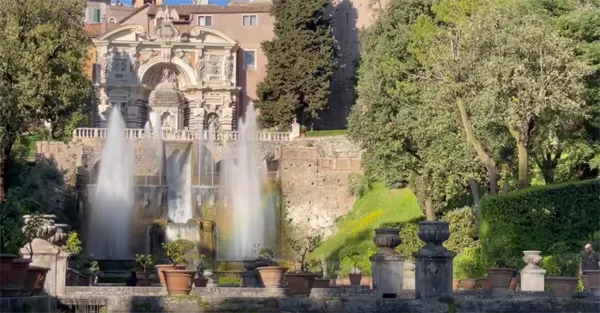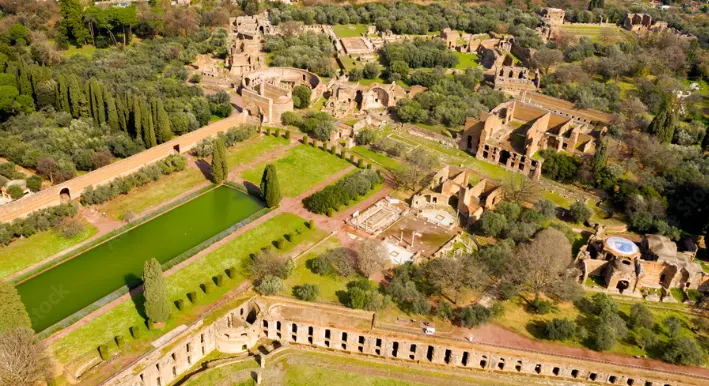Step into the luxurious past of Ancient Rome and Renaissance Rome
Rome day trip to Tivoli to visit Villa Adriana and Villa d’Este is popular among locals and tourists. Visitors and Romans alike enjoy the retreat from Rome. The town provides a peaceful escape from the bustling city life.
Tivoli, a charming town just outside Rome, is home to two villas that are Italy UNESCO World Heritage sites. The magnificent Villa d’Este is a Renaissance gem. Hadrian’s Villa Adriana dates to the ancient Roman emperor Hadrian.
Their setting is the scenic hills of the Italian countryside. It offers a serene atmosphere and stunning views of the surrounding landscape.
Visitors flock to Tivoli to explore its historical sites, lush gardens, and majestic villas. The center of Tivoli the town is a gem in itself. Tivoli is the perfect complement to the grandeur of the villa. The cobbled streets, charming cafes, and friendly locals provide nice atmosphere to enjoy the day trip from Rome.
Don’t forget to explore the historic center. There you’ll also find the medieval Rocca Pia fortress and the picturesque Piazza dell’Olmo.
Guided Tour from Rome to Tivoli Villa d’Este and Hadrian’s Villa Adriana
Villa d’Este

Villa d’Este, surrounded by lush gardens, holds a rich history and breathtaking beauty that captivates visitors of all ages. You enter through Piazza Trento.
Villa d’Este’s setting is like a fairy tale come to life. Cardinal Ippolito II d’Este built it in the 16th century. The villa is a masterpiece of Renaissance architecture and landscape design.
A grand facade adorned with intricate sculptures and elegant gardens and fountains greets visitors. The villa’s interior is equally impressive, featuring opulent rooms decorated with frescoes, marble floors, and ornate furnishings. Each chamber tells a story of the villa’s illustrious past. Visitors transport back in time to the Italian Renaissance era.
Gardens and Fountains
The true marvel of Villa d’Este lies in its magnificent gardens. They are among the finest in Italy. The gardens boast a stunning array of flora, including vibrant flowers, lush trees, and aromatic herbs. You may stroll around the gardens spread across several terraces,.
The gardens include fountains, cascades, and pools, each more enchanting than the last. What truly sets Villa d’Este apart are its elaborate water features, which are a masterpiece of hydraulic engineering.
The fountains here are not just decorative; they are a symphony of water and art. The clever engineering of the Renaissance architects allows water to dance and play, creating a refreshing and delightful atmosphere. The impressive use of water to bring life to the gardens showcases Renaissance ingenuity.
For example, one of the highlights of a visit to Villa d’Este is the famed Water Organ. The fountain is a unique musical instrument powered by water pressure. The water flowing its pipes creates beautiful melodies. The music echos through the gardens, adding an ethereal soundtrack to your exploration.
This unique fountain is a must-see, as it demonstrates the creativity and imagination of the Renaissance period. Imagine strolling through the garden while the gentle sound of water music fills the air – it’s an experience that stays with you.
The Fontana dell’Ovato, with its oval-shaped pool and grottoes, is particularly captivating. The famous Hundred Fountains is a long path adorned with countless symmetrical water jets and basins.
The Villa
As you explore the villa, you’ll come across magnificent frescoes and ornate rooms that tell the story of its past. Each room is like a chapter in a history book, showcasing the luxurious lifestyle of the Renaissance elite. The Hall of the Fountain and the Room of the Eagles are particularly impressive. Intricate decorations adorn the rooms, transporting you back in time.
The views from Villa d’Este are equally stunning. Perched on a hill, the villa offers panoramic vistas of Tivoli and the surrounding countryside. Pause in its picture-perfect setting. Then, take a deep breath, and appreciate the beauty of nature.
Visiting Tivoli and Villa d’Este is like stepping into a storybook. It’s a place where history, art, and nature come together to create an unforgettable experience. History enthusiasts and nature lovers will enjoy a magical escape to Tivoli.
So, take a day trip from Rome, immerse yourself in the beauty of Tivoli. Let the enchantment of Villa d’Este weave its spell on you.
Hadrian’s Villa Adriana

Villa Adriana stands as an unparalleled testament to the grandeur and architectural prowess of ancient Rome. Built during the 2nd century AD today it is a sprawling archaeological site. It served as the lavish retreat and imperial residence for the Roman Emperor Hadrian.
The site spreads across approximately 250 acres. Hadrian’s Villa is one of the largest and most opulent estates in the Roman Empire. Its architectural magnificence, diverse structures, and lush landscapes provide a fascinating glimpse into the luxurious lifestyle of the emperor.
The villa’s architectural design reflects Hadrian’s admiration for various cultures and regions he encountered during his extensive travels. Greek, Egyptian, and Roman influences seamlessly blend in a harmonious tapestry of structures. The influences mix to create a unique and visually stunning environment. The site provides a glimpse into the eclectic tastes of one of Rome’s most influential emperors.
Maritime Theater

One of the standout features of Hadrian’s Villa is the Maritime Theater, a circular structure surrounded by a moat. This distinctive retreat was likely a private sanctuary for Hadrian, offering a serene escape within the expansive estate. The villa incorporates water features like pools, canals, and reflective surfaces throughout its design. They make the villa look beautiful.
Ancient Egyptian and Ancient Greece Influence
The Canopus, a large reflecting pool surrounded by columns, draws inspiration from the ancient Egyptian city of Canopus. This area served as a venue for extravagant banquets and social gatherings. It showcases the Romans’ mastery in incorporating diverse architectural elements to create a unique and opulent space.
Adjacent to the Canopus is the Serapeum, a temple dedicated to the Egyptian god Serapis. This temple and the other structures reflect Hadrian’s fascination with Greek and Egyptian art and culture.
The Pecile courtyard surrounded by columns provided a space for walking and socializing. The Poikile served as a site for philosophical discussions.
The meticulous planning and execution of Hadrian’s Villa extend to the theatres, libraries, and thermal baths. Hadrian’s Villa Adraina demonstrates the emperor’s practical approach to combine leisure and functionality within a single estate.
Today Hadrian’s Villa stands as a UNESCO World Heritage Site and a captivating tourist destination. Exploring the well-preserved ruins transports visitors back in time. Visitors marvel at the remnants of majestic structures, statues, and intricate mosaics that once adorned the imperial residence.
The site offers a captivating journey through the centuries. It allows individuals to envision the once-vibrant life that unfolded within these ancient walls.
Hadrian’s Villa, with its expansive grounds and diverse architectural elements, serves as a testament to the enduring legacy of Roman engineering and artistic ingenuity.
Hadrian’s Villa is like a living history book. It shows how rich and diverse the Roman Empire was. When people visit, they get a real connection to the past, stepping into the luxurious heart of ancient Rome.
Rome Day Trip to Tivoli: Getting There From Rome
Train
You can take a train from Rome to Tivoli. Trains to Tivoli depart from Roma Termini, the main railway station in Rome. The journey to Tivoli station takes approximately 30-50 minutes, depending on the type of train (regional or express). Check the train schedule and platform information at Roma Termini.
Bus
Buses also connect Rome to Tivoli. You can take a Cotral bus from Ponte Mammolo metro station in Rome to Tivoli. The journey typically takes around 50 minutes to an hour.
Car
Although we do not suggest renting a car, if you prefer flexibility, you can rent a car or take a taxi. Tivoli is about 20 miles east of Rome. The journey takes approximately 30-40 minutes by car, depending on traffic conditions.
Guided Tours
There are also organized tours that include transportation from Rome to Tivoli. Tours provide a convenient way to explore Tivoli’s attractions like Villa d’Este and Hadrian’s Villa.
You may also consider a tour of Italy that includes Tivoli. The 12-Day Rome, Amalfi Coast, Florence, Venice tour all-inclusive Italy tour includes an optional tour to Tivoli.



